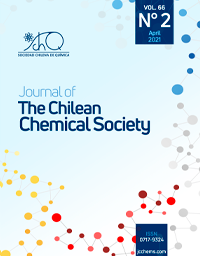
- Imprinted polymer, Recognition, Dye, Basic Blue 41
Copyright (c) 2021 SChQ

This work is licensed under a Creative Commons Attribution-NonCommercial-ShareAlike 4.0 International License.
Abstract
This study reports a novel imprinted molecular poly(ethylene terephatalate) (MIPBB41) for the binding and selective recognition of an azoic dye (basic blue 41) by a non-covalent imprinting approach. Basic blue 41 (BB41) was chosen as the template molecule, acrylic acid-grafted polyethylene terephthalate (PET-g-AA), and N,N’-methylene-bis-acrylamide (MBA) were used as the functional polymer and crosslinking reagent respectively. To determine the binding capacity of MIPBB41, several adsorption studies were performed. The adsorption isotherm was described by the Langmuir model, and the maximum adsorption capacity of MIPBB41 toward basic blue 41 reached 144.8 mg g-1in water at pH 6.2. The fabricated MIP showed good recognition properties. In a further experiment, the adsorption capacity of the MIP was compared to the non-imprinted polymer (NMIP), and a recognition coefficient of 3.14 was obtained.

References
- M. Bassim, International of Advanced Research in Chemical Science. 1, 48, (2014)
- S. Bae, S. Freeman, D. Kim, Fiber Polymer. 7, 30, (2006)
- M. Abassi, N. Asl, Journal of Hazardous Materials. 153, 942, (2008)
- M. Roulia, A. Vassiliadis, Journal of Colloid and Interface Science. 291, 37, (2005)
- N. Atar, A. Olgun, F. Çolak, Engineering Life Science. 5, 499, (2008)
- Y. Wong, Y. Szeto, W. Cheung, G. McKay, Langmuir. 19, 7888, (2003)
- G. Crini, Dyes and Pigments. 2, 415, (2008)
- M. Rafatullah, O. Sulaiman, R. Hashim, A. Ahmad, Journal of Hazardous Materials. 170, 70, (2010)
- W. Ngah, C. Teong, M. Hanafiah, Carbohydrate Polymers. 83, 1446, (2011)
- H. Qiu, L. Lv, B. Pan, Q. Zhang, W. Zhang, Q. Zhang, Journal of Zhejiang University-SCIENCE A. 10, 716, (2009)
- W. Wang, Y. Xie, Y. Zhang, S. Tang, C. Guo, J. Wu, R. Lau, Chemical Engineering Research and Desig. 114, 258, (2016)
- J. Fu, Q. Xin, X. Wu, Z. Chen, Y. Yan, S. Liu, M. Wang, Q. Xu, Journal of Colloid and Interface Scienc. 461, 292, (2016)
- Q. Lin, M. Gao, J. Chang, H. Ma, Carbohydrate Polymer. 151, 283, (2016)
- I. Nicholls, O. Ramström, K. Mosbach, Journal of Chromatography A. 691, 349, (1995)
- P. Sharma, Z. Iskierko, A. Pietrzyk-Le, F. D’Souza, W. Kutner, Electrochemistry Communication. 50, 81, (2015)
- T. Shahar, N. Tal, D. Mandler, Colloids and Surfaces A: Physicochemical and Engineering Aspect. 495, 11, (2016)
- Z. Iskierko, P. Sharma, K. Bartold, A. Pietrzyk-Le, K. Noworyta, W. Kutner, Biotechnology Advance., 34, 30, (2016)
- M. Gama, C. Bottoli, Journal of Chromatography B. 1043, 107, (2017)
- L. Figueiredo, G. Erny, L. Alves, Talanta. 146, 754, (2016)
- A. Sarafraz-Yazdi, N. Razavi, Trends Analytical Chemistr. 73, 81, (2015)
- D. Campbell, K. Araki, D. Turner, Journal of Polymer Science Part A. 4, 2597, (1966)
- S. Rath, M. Patri, S. Sharma, K. Sudarshan, P. Pujari, Radiation Physics and Chemistry. 79, 745, (2010)
- X. Ping, M. Wang, X. Ge, Radiation Physics and Chemistry. 80, 567, (2011)
- V. Litvinov, H. Barthel, J. Weis, Macromolecules. 35, 4356, (2002)
- C. Sulitzky, B. Rückert, A. Hall, F. Lanza, K. Unger, B. Sellergren, Macromolecules, 35, 79, (2002)
- J. Trgo, N. Medvidović, Water Research. 38, 1893, (2004)
- J. Rouquerol, F. Rouquerol, P. Llewellyn, G. Maurin, K. Sing, Adsorption by powders and porous solids: principles, methodology and applications; Elsevier: Oxford, 2014; pp. 11-14. Chapter 1.
- R. Umpleby, S. Baxter, Y. Chen, R. Shah, K. Shimizu, Analytical Chemistry. 73, 4584, (2001)
- R. Umpleby, S. Baxter, M. Bode, J. Berch, R. Shah, K. Shimizu, Analytica Chimica Acta. 435, 35, (2001)
- H. Guo, X. He, Fresenius J Anal Chem. 368, 461, (2000)
- T. Takeuchi, T. Mukawa, J. Matsui, M. Higashi, D. Shimizu, Analytical Chemistr 73, 3869, (2001)
- C. Zhao, T. Zhao, X. Liu, H. Zhang, Journal of Chromatography A. 1217, 6995, (2010)

